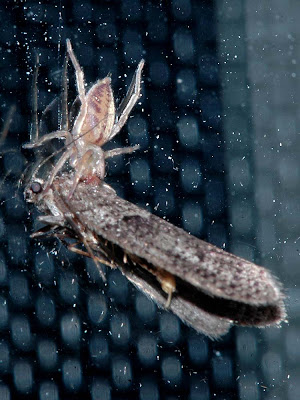These insects were around my house in late April.
The first is a moth which will never come back again - for obvious reasons - it has been captured by a small Triangular Spider (or is it more properly called Jumping Spider?).
"The one the spider has is Oenosandra boisduvalii."DJW Comment: Here is Donald Hobern's image of that species.
I would have to say I am not totally convinced it is the same species.
That particular window was brand new at that stage, and it was not dirty, as it appears. Moths are covered with tiny scales, which tends to make them very smooth to our touch - almost waxy, sometimes. That is because they shed these scales very easily. It is that characteristic which has resulted in the spots all over my brand new window - moth scales shed as the moth tried to beat its wings in a frenzy, trying to escape the clutches of the spider.
This spider does not rely on a web to trap its prey, it pounces on its prey - that's why such spiders are often referred to as "jumping spiders". Obviously once the poison of the spider's bite takes effect, the Spider then holds on and begins to suck the juices from the moth, and then the Spider will simply drop the dried up moth, and go on its way.
This is Niceteria macrocosma (in the Ennominae group) according to Donald Hobern's Moth Gallery. In my notes on filing this Moth image, I have referred to it as a "round headed" moth.
 Duncan has said: "The one named Niceteria macrocosma is actually Proteuxoa tortisigna in the Noctuidae."
Duncan has said: "The one named Niceteria macrocosma is actually Proteuxoa tortisigna in the Noctuidae."Denis says, that image from Duncan's (DJW - Correction: Donald Hobern's) moth gallery is a great match for my Moth. Thanks Duncan for directing me to it.
I believe that this pretty little green camouflaged moth is :Aeolochroma metarhodata. As usual, with moths, I might be wrong.
 Duncan has said: Here's a picture of Aelochroma metarhodata
Duncan has said: Here's a picture of Aelochroma metarhodatafrom my gallery, it differs a lot from your last one that I haven't seen: http://www.natureofgippsland.org/coppermine/displayimage.php?album=54&pos=65
That is polite Blogger speak for saying that I have the wrong name, but he likes my Moth (whatever it might be).
Edit: Donald Hobern has come through (in the comments below) with a name for this pretty green moth. Thalatha trichroma Many thanks Donald.
This dear little fellow is a Cricket, but I am afraid i cannot say what type. But I like its fine antennae. I can say that it is much smaller and lighter in body than the huge Illawarra Raspy Crickets which I get here.
 I have received a message from the Nature Blogger, Duncan, who writes the Ben Cruachan Blog.
I have received a message from the Nature Blogger, Duncan, who writes the Ben Cruachan Blog.He has kindly offered correct names for the moths I named, and a name for the one I did not attempt to name.
"The one named Niceteria macrocosma is actually Proteuxoa tortisigna in the Noctuidae.
The one the spider has is Oenosandra boisduvalii.
He has also added: Here's a picture of Aelochroma metarhodata from my gallery, it differs a lot from your last one that I haven't seen: http://www.natureofgippsland.org/coppermine/displayimage.php?album=54&pos=65"
Duncan was almost apologetic about suggesting corrections, but he understands that I like my Blog to be accurate, where possible. I have thanked him for the suggested names.


3 comments:
Hi Denis.
I'd agree that the moth being eaten by the spider is probably not Oenosandra boisduvalii - it looks more like one of the Psychidae in the genus Lepidoscia (e.g. http://www.flickr.com/photos/dhobern/3285247059/) but that's a group that needs a lot of attention.
I'd green one is another noctuid - something closer to Epicyrtica metallica - http://lepidoptera.butterflyhouse.com.au/amph/metallica.html
Best wishes,
Donald
Thanks Donald
Aaah, guess-work can only take me so far.
I appreciate your guidance in identifying these Moths.
Denis
Found the green one - it's Thalatha trichroma - http://www1.ala.org.au/gallery2/v/Noctuidae/Acronictinae_Amphipyrinae/Thalathatrichroma/thalatha_trichroma_01.jpg.html
Best wishes,
Donald
Post a Comment